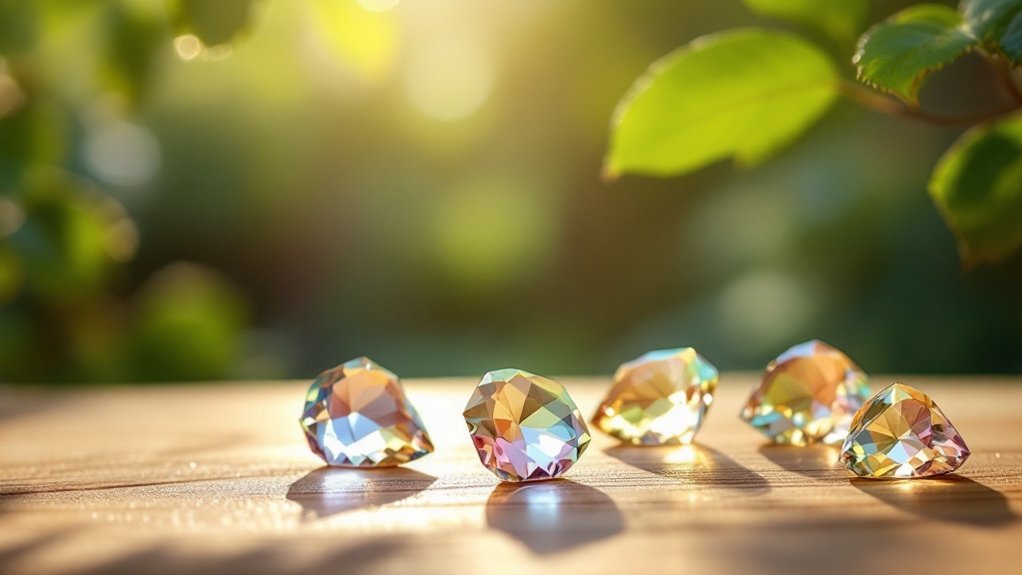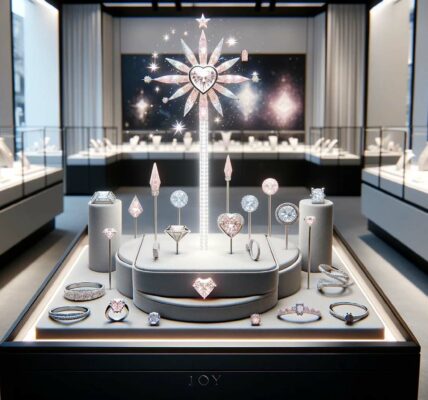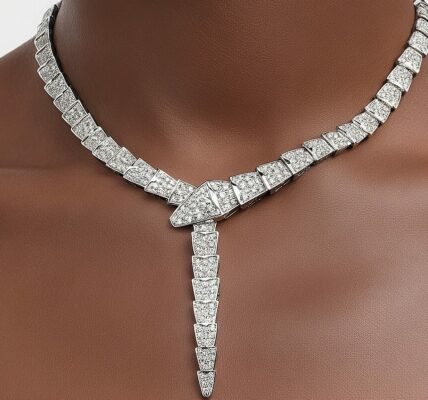Swarovski has announced its ReCreated Crystals, marking a pivotal advancement in sustainable luxury. With a groundbreaking remelting technique, these crystals transform manufacturing breakage into striking new hues such as Ice Blue and Dark Jonquil, aligning with the esteemed principles of a circular economy. Each piece retains the signature brilliance of traditional Swarovski lines while minimising natural resource use by 40% and reducing energy consumption by 26% since 2010. Such efforts are complemented by a visionary pledge to achieve a 47% reduction in carbon emissions by 2030, reimagining elegance with a conscious twist. Discover how Swarovski unites style with sustainability.
Article Contents
Main Highlights
- Swarovski's ReCreated crystals use remelting to transform waste into sustainable multicoloured crystal shades.
- The crystals consume 40% fewer natural resources and have reduced energy consumption by 26% since 2010.
- Swarovski aims for 90% landfill-free operations and a 47% reduction in carbon emissions by 2030.
- ReCreated crystals are integrated into collections like Millenia, showcasing innovative sustainable colours.
- Swarovski is committed to using 100% renewable electricity in its Asian manufacturing sites by 2030.
ReCreated Crystals Explained
Swarovski's ReCreated crystals embody a remarkable advancement in sustainable manufacturing. These exquisite jewels are crafted using a groundbreaking remelting technique, where multicoloured breakage from the manufacturing process is transformed into stunning new shades. By adopting a circular approach, Swarovski guarantees that waste isn't discarded, but instead, given a new life in the form of lively crystals. This process not only highlights the brand's commitment to sustainability but additionally showcases their mastery in creating extraordinary colour varieties like Ice Blue and Dark Jonquil, released annually to captivate admirers worldwide. Despite their recycled origin, these ReCreated crystals boast the same crystal durability and impeccable quality as standard Swarovski offerings. By significantly reducing their reliance on natural resources, Swarovski also manages to shrink its environmental footprint by at least 34%. Furthermore, these crystals utilise at least 40% fewer natural resources than standard crystals, reflecting the brand's leadership in sustainable practices within the industry. The durability guarantees that whether adorned in legendary collections such as Sublima and Millenia or incorporated into bespoke jewellery pieces, they withstand the test of time. In both B2B and B2C markets, these crystals offer a luxurious experience without compromising on environmental values. Swarovski's ReCreated crystals stand as an indication of the brand's creative spirit, skilfully bridging the gap between sustainability and artistry, appealing to an audience that cherishes both freedom in design and the planet's well-being.
Environmental Benefits
ReCreated crystals similarly showcase artistic innovation but moreover significantly contribute to environmental sustainability. Swarovski's commitment to green technology has led to a 34% reduction in their environmental footprint, emphasising resource efficiency. By utilising 40% fewer natural resources, they've set a benchmark in the jewellery industry for ecological responsibility. This shift isn't just environmentally prudent but also economically savvy, as remelting breakage from the crystal manufacturing process reduces waste and aligns with circular innovation goals. As part of their dedication to sustainability, Swarovski plans to launch at least one sustainable collection annually starting in 2023. Incorporating these eco-conscious practices into collections like Millenia and Sublima, Swarovski exemplifies how luxury and sustainability can coexist. Their efforts have yielded a 26% reduction in total energy consumption since 2010, with a notable 59% decrease in Scope 1 carbon emissions at their main manufacturing site. The use of renewable sources for a third of their energy, along with 100% renewable electricity at their Asian sites, underscores their dedication to environmental stewardship. Water conservation forms an essential part of their strategy, with 76% of water demands met through recycled sources in 2018. This approach, coupled with waste management initiatives aiming for 90% landfill-free operations by 2030, highlights Swarovski's commitment to a sustainable future. By focusing on sustainable production and consumption, Swarovski inspires designers, collaborators, and customers to adopt eco-friendly practices.
Commitment to Sustainability
Swarovski has consistently demonstrated a strong commitment to sustainability, a path that began with their first voluntary sustainability report in 2010. By aligning with GRI Standards, Swarovski set a precedent for transparency and ambition beyond mere legal compliance. Their expedition reveals a combination of sustainable sourcing and ethical practices, vital in the fashion and jewellery industry. Over the years, Swarovski has pioneered initiatives like the Responsible Sourcing Initiative, launched in 2014, which helps suppliers manage socio-environmental risks—an integral step in ethical practices. The company's dedication extends to reducing lead content in their crystals, a milestone achieved in 2015 when they reached a mere 0.004%. This commitment is matched by their strategic 2020 vision, setting bold targets for 2030, signalling a commitment to continuous improvement. Social audits of suppliers guarantee that their supply chain maintains these stringent standards, embodying a holistic approach to sustainability. With a history of utilising local renewable hydroelectric energy since 1895, Swarovski's commitment to renewable energy sources has continued to evolve, enhancing energy efficiency in operations. Moreover, Swarovski's partnership with suppliers in 2022 to shift to renewable electricity in the production of Swarovski Zirconia reflects their creative spirit. This dynamic pursuit of sustainability not only amplifies the brand's legacy but also aligns with the desires of a free-spirited audience yearning for responsibility and elegance.
Innovative Production Process
Through a creative production process, Swarovski transforms crystal manufacturing breakage into new crystals, ensuring nothing goes to waste. This groundbreaking approach of breakage remelting forms the backbone of their circular economy efforts, making certain that materials continue to serve their purpose rather than contributing to waste. Each re-created crystal boasts the same impeccable quality as its original counterpart, maintaining the brand's reputation for distinction. In line with Swarovski's ethos, their Millenia collection highlights this innovative use of ReCreated™ Crystals, blending classic heritage designs with sustainable practices.
In addition to these efforts, Swarovski integrates their ReCreated™ Crystals across collections, launching new hues annually to expand their colour offerings. Swarovski's commitment to sustainability is reflected in their resource reduction strategy, using at least 40% fewer natural resources. This approach not only conserves precious materials but also slashes their environmental footprint by a minimum of 34%. The multicoloured breakage is artfully remelted into a single, new hue, showcasing the brand's mastery in cutting-edge design.
| Aspect | Details | Impact |
|---|---|---|
| Breakage Remelting | Transforms waste into new crystals | Supports circular economy |
| Resource Reduction | 40% fewer natural resources used | Conservation of natural resources |
| Environmental Footprint | 34% reduction in impact | Less environmental strain |
As production sites shift to renewable energy sources, Swarovski's investment in photovoltaics and electric boilers highlights their dedication to efficiency. Their efforts embody a sophisticated balance of quality and sustainability, making certain Swarovski remains a leader in sustainable luxury.
Future Sustainability Plans
Looking ahead, Swarovski is gearing up to transform its sustainability efforts with ambitious future plans. By 2030, they're aiming for a 47% reduction in Scope 1 and 2 emissions and a 28% cut in Scope 3 emissions. These goals are bolstered by their commitment to 100% renewable electricity in Asian manufacturing sites.
Swarovski's main crystal manufacturing site in Wattens, Austria, has already achieved a 59% drop in Scope 1 carbon emissions since 2010, showcasing their dedication to sustainable practices.
In addition to renewable energy, Swarovski's future innovations include adopting a circular economy model and waste management strategies. They're on track to achieve 90% landfill-free operations by 2030, with 70% of waste recycled or repurposed.
Their ReCreatedTM Crystals and Galaxy collection demonstrate a commitment to using fewer natural resources and recycled materials, highlighting their forward-thinking approach.
Furthermore, Swarovski plans to focus on conscious materials and supply chain improvements, prioritising responsibly managed and recycled suppliers.
Education and empowerment initiatives will inspire sustainable practices across designers, collaborators, and customers, aligning with their vision for a transparent, sustainable future in the jewellery industry.




